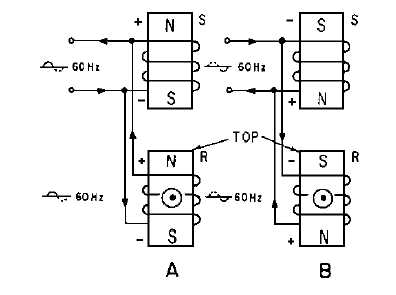1-19
Figure 1-12.—Operation of fixed and moveable electromagnets with ac voltage.
In this figure, both stationary and rotating coils are connected to the same 60-Hz source. During the
positive alternation (view A), the polarities are as shown and the top of the rotor is attracted to the bottom
of the stationary coil. During the negative alternation (view B), the polarities of both coils reverse, thus
keeping the rotor aligned in the same position. In summary, since both magnetic fields change direction at
the same time when following the 60-Hz ac supply voltage, the electromagnetic rotor does not change
position because it is always aligned with the stationary magnetic field.
Q-18. How do synchros differ from conventional transformers?
Q-19. Describe the zero-position of a synchro transmitter.
SYNCHRO TORQUE TRANSMITTER
The synchro transmitter converts the angular position of its rotor (mechanical input) into an electrical
output signal.
When a 115-volt ac excitation voltage is applied to the rotor of a synchro transmitter, such as the one
shown in figure 1-13, the resultant current produces an ac magnetic field around the rotor winding. The
lines of force cut through the turns of the three stator windings and, by transformer action, induce voltage
into the stator coils. The effective voltage induced in any stator coil depends upon the angular position of
that coil's axis with respect to the rotor axis. When the maximum effective coil voltage is known, the
effective voltage induced into a stator coil at any angular displacement can be determined.

